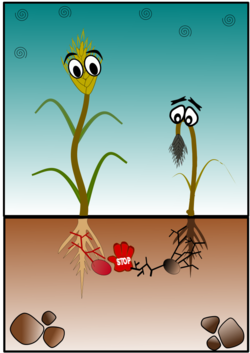Understanding of Below-ground Plant and Fungus Communication
Plants serve as a major source of organic carbon to the belowground microbial community including several fungi. These fungi thrive to utilize photosynthesized sugar molecules through plant roots. Some of them are pathogenic fungi, which interact aggressively leading to plant death. In contrast, some other fungi methodically colonize living roots without causing any harm to the host. This second group of fungi establishes symbiosis with the host plant. In exchange of plant sugar, some of them also protect the plant from aggressive pathogenic fungi and therefore, are possible candidates to explore their molecular function as biocontrol agents in agriculture. The molecular mechanism behind communication among plant and fungal partners is largely unknown. A detailed analysis of plant interaction with symbiotic fungi versus pathogenic fungi is needed in establishing sustainable agricultural practice.
Root communication with fungi: Symbiosis versus Pathogenesis
We are studying root colonization of barley with a root symbiont, Sebacina vermifera as well as with a phytopathogen, Bipolaris sorokiniana. S. vermifera was first isolated from a terrestrial Australian orchid root. It belongs to the order Sebacinales (Basidiomycota). S. vermifera is considered as an orchid mycorrhizal fungus (ORM) because of its capability to stimulate seed germination and seedling development in these natural hosts. It also showed beneficial effects such as growth promotion and resistance to biotic or abiotic stresses in a wide spectrum of experimental hosts including barley, switchgrass and tobacco. Environmental molecular analyses have found a ubiquitous distribution of closely related Sebacinales within various plants including Arabidopsis thaliana (mouse-ear cress, a widely used model plant), Triticum aestivum (wheat) and Zea mays (maize).
Recently, the genome of S. vermifera was sequenced in co-operation with the DOE Joint Genome Institute (JGI) in USA. S. vermifera is particularly well equipped with genes encoding lectins, carbohydrate-active enzymes as well as many proteinases that can potentially degrade plant cell walls and modify fungal cell walls, respectively. It encodes more hydrolytic enzymes than the average of ~60 other genomes examined. However, a detailed molecular mechanism of how the symbiotic fungus establishes itself in a metabolically active root is still unknown.
B. sorokiniana is an aggressive ascomycete fungus and is a serious threat to cereal crops. In agro-economy, significant amount of crop-loss occurs every year because of B. sorokiniana. It causes leaf spot blotch and common root rot diseases in barley and wheat. In the root of barley this fungus displays an early biotrophic phase during which the root cells remain alive, and then quickly switches to a necrotrophic phase resulting in root cell death and browning. The genome of B. sorokiniana was sequenced and genome analysis identified the presence of small secreted proteins which could be involved in host colonization.
Fungal secondary metabolism plays often a pivotal role in fungal virulence. Polyketide synthases and non-ribosomal peptide synthetases which are involved in melanin synthesis, secondary metabolites production and oxidative stress responses, were reported to be involved in infection of barley by B. sorokiniana. However, a detailed molecular mechanism of B. sorokiniana caused pathogenesis remained unexplored.
Strategy to understand the communication
To address how plants communicates with two apparently contrasting fungi and how the symbiont is able to protect barley from the activity of the pathogen, within CEPLAS our research uses integrated approaches that rely on comparative transcriptomics, reverse genetics and cell biology. We compare the plant response towards the symbiont with that towards the pathogen. The comparative study on the mechanism behind the beneficial effect of S. vermifera and the deleterious effects of B. sorokiniana, will lead to a better understanding of the colonization dynamic of root-fungus interactions. Some of the data indicates that a possible inter-fungal communication additionally plays a major role in biological control function of S. vermifera in barley root (Figure 1.). Therefore, together with a detailed transcriptomic analysis of plant and fungus interaction, a detail introspection of the fungus versus fungus interaction is included in our study to address the specific biological questions. The insight from the study would help in better understanding of the biocontrol function in sustainable agricultural practice.
Debika Sarkar, University of Cologne, Institute for Genetics
Planter’s Punch
Under the heading Planter’s Punch we present each month one special aspect of the CEPLAS research programme. All contributions are prepared by our young researchers.
Further Reading
Kohler A, Kuo A, Nagy LG, Morin E, Barry KW, Buscot F, Canback B, Choi C, Cichocki N, Clum A, Colpaert J, Copeland A, Costa MD, Dore J, Floudas D, Gay G, Girlanda M, Henrissat B, Herrmann S, Hess J, Hogberg N, Johansson T, Khouja HR, LaButti K, Lahrmann U, Levasseur A, Lindquist EA, Lipzen A, Marmeisse R, Martino E, Murat C, Ngan CY, Nehls U, Plett JM, Pringle A, Ohm RA, Perotto S, Peter M, Riley R, Rineau F, Ruytinx J, Salamov A, Shah F, Sun H, Tarkka M, Tritt A, Veneault-Fourrey C, Zuccaro A, Mycorrhizal Genomics Initiative C, Tunlid A, Grigoriev IV, Hibbett DS, Martin F (2015) Convergent losses of decay mechanisms and rapid turnover of symbiosis genes in mycorrhizal mutualists. Nature genetics 47(4):410-415. [Abstract]
Lahrmann U, Strehmel N, Langen G, Frerigmann H, Leson L, Ding Y, Scheel D, Herklotz S, Hilbert M, Zuccaro A (2015) Mutualistic root endophytism is not associated with the reduction of saprotrophic traits and requires a noncompromised plant innate immunity. The New phytologist 207(3):841-857. [Abstract]
